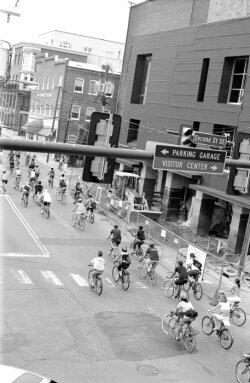Critical mass: Cyclists hog to unclog
"We are one large vehicle," came a shout from the crowd of bicycles near the Downtown Mall on the last Friday of August.
At 5:30pm, presumably when most people were getting in their cars to drive home from work, the approximately 50 cyclists took to the street. Occupying an entire lane as they rode west on Main Street, they effectively formed a large vehicle and slowed the car traffic that usually rules the road.
Although the recent gathering included everyone from young college radicals to a mother and child, one purpose seemed to unite all the riders: to have fun while making a statement.
It's called Critical Mass, and according to organizers, it's part protest, part community gathering, part social movement, and part parade.
"Doing Critical Mass," says participant Gene Osborn, "lightens the spirits."
Some motorists caught behind the cyclists were not so jovial.
"It stinks," said Rebecca Wells, as she sat in her blue minivan behind the bikes. A passenger with Wells noted that the ride's slow pace, not the presence of the bikes, was causing their frustration.
Organizers of Critical Mass– in which five or six cyclists ride abreast– claim they do not intentionally violate traffic laws.
Charlottesville City Code, however, makes the action sound a lot like civil disobedience: "Persons riding bicycles or mopeds upon streets or highways shall not ride two (2) or more abreast."
According to Sergeant Ronnie Roberts of the Charlottesville Police Department, bikes are supposed to follow the same rules of the road as cars. He was unaware of any arrests or citations stemming from the event.
The reasons for participating in Critical Mass are as numerous as the riders. While some view it as a way to speak out against pollution, others envision a more personable community without cars. Some just want to raise awareness about bikes on public roads.
"It's a protest in that it's people showing the contrast between what they are now and what they could be," says organizer Alex Davis, quickly adding that the "community gathering" aspect is as important as the protest.
The monthly ride grew out of a class project at Piedmont Virginia Community College. "I realized," says Davis, "I wanted to do more to make bicycling a more visible alternative to cars."
So this past June, Davis put up posters and convinced about 20 like-minded souls to join him in the first monthly ride. And thus was born the current incarnation of Critical Mass in Charlottesville.
The local effort is part of a much larger movement in which cyclists in hundreds of cities worldwide gather on the last Friday of every month to make their presence known to drivers.
Originally called Commuter Clot, when the first ride occurred over 10 years ago in San Francisco, the event came to be dubbed Critical Mass after those words were used to describe cyclists in China gathering in sufficient numbers to force cars to yield.
Although the objective of flooding the road with bikes might seem anti-car to some observers, most participants see it differently. "It's for bikes," says Osborn. "It's not against cars."
Osborn says he appreciates the usefulness of cars and even enjoys driving. He believes, however, that bikes are better for intra-city travel. "I choose biking over driving, but I do not choose biking exclusively," he says.
While there's no political arm of Critical Mass lobbying for more bike lanes or bike-friendly laws, the monthly ride does not go unnoticed in City Hall.
"I think it's the biggest visible symbol that there already is a critical mass of bikers in town," says Mayor Maurice Cox, who has participated in the rides.
Mayor Cox says the City is working to make bike-commuting more viable by increasing the mileage of bike lanes and trails and encouraging businesses to install showers.
The mass in Critical Mass makes Cox believe the City is moving in the right direction. "It just reaffirms my conviction that we're on the right track," says Cox, "and we need to respond to this demand."
